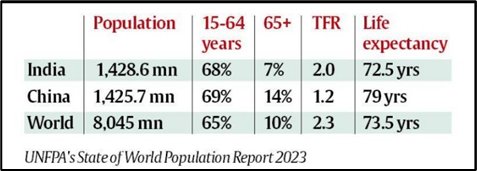ForumIAS announcing GS Foundation Program for UPSC CSE 2025-26 from 27th May. Click Here for more information.
Contents
Source: The post is based on the following articles
– “India’s population to edge ahead of China’s by mid-2023, says U.N.” published in The Hindu on 20th April 2023
– “India becomes world’s most populous nation: What’s behind the population numbers?” published in Indian Express on 20th April 2023
What is the News?
The UN Population Fund (UNFPA) has released the State of World Population Report, 2023.
What are the key findings of the report?
Globally: The population of the world is 8,045 million.
– Out of this, the largest share (65%) is of people between the ages of 15 – 64 years, followed by those in the 10-24 years group (24%).10% of the population is above 65 years of age.
Most populous regions: The world’s two most populous regions are Eastern and South-Eastern Asia [2.3 billion people – 29% of the global population]; and Central and Southern Asia [2.1 billion – 26%].
– China and India accounted for the largest populations in these regions, with more than 1.4 billion each in 2022.
Rate of population growth: The rate of global population growth has fallen, and has been at less than 1 per cent since 2020.
– This is primarily due to declining fertility. Around two-thirds of people live in a country or area with a total fertility rate at or below 2.1 children per woman (widely considered the “replacement fertility” rate, also called the “zero-growth fertility” rate). In 1950 the global fertility rate stood at 5.
Life expectancy: The life expectancy among men now stands at 71 years while among women it stands at 76 years.
Future Projections: The global population could grow to around 8.5 billion in 2030, 9.7 billion in 2050 and 10.4 billion in 2100.
– Central and Southern Asia are expected to become the most populous region in the world by 2037.
– More than half of the projected increase in global population up to 2050 will be concentrated in eight countries – Congo (DRC), Egypt, Ethiopia, India, Nigeria, Pakistan, the Philippines and Tanzania.
What does the State of World Population Report, 2023 say about India?

India now has 1,428.6 million people and is the most populous country in the world, outstripping China’s population.
As much as 68% of India’s population belongs to the 15-64 years category, and 26% in the 10-24 years group, making India one of the youngest countries in the world.
However, the fertility rate in India has been steadily dropping. The National Family Health 5 Survey (2019-21) found that India attained a Total Fertility Rate of 2.0 for the first time, less than the replacement level of 2.1, falling from 2.2 in NFHS 4 (2015-16).
The increased use of contraceptive methods, spacing of pregnancies, access to health care and the impetus to family planning, besides increasing wealth and education, has contributed to the growth rate of the population slowing.
What does this mean for India?
India is in a unique position where the young and working population is larger than the population that needs care (children and the elderly).
This is unlike countries such as Japan with a declining population and an increasingly elderly population.
Such countries are, and will be, in dire need of skilled labour, and this is something that India can provide, capitalizing on its demographic dividend.
What are the suggestions given by the report?
The report has called for a radical rethink on how countries address changing demographics and cautioned against the use of family planning as a tool for achieving fertility targets.
It warned that global experience showed that family planning targets can lead to gender-based discrimination and harmful practices such as prenatal sex determination leading to sex-selective abortion.
Instead, it strongly recommended that governments introduce policies with gender equality and rights at their heart, such as parental leave programmes, child tax credits, policies that promote gender equality in the workplace, and universal access to sexual and reproductive health and rights.




